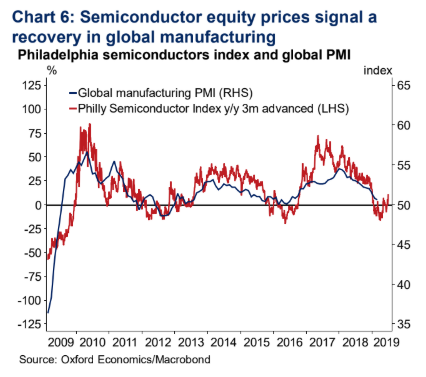Here’s one sign that an economic slowdown sweeping the globe may be petering out: semiconductors are bursting higher.
The 27% surge in the PHLX Semiconductor index SOXX, -0.01% this year has taken the popular benchmark of companies that produce microchips to all-time highs, and that has analysts at Oxford Economics seeing a brightening picture for the economy internationally.
A recent run-up in the PHLX Semicondcutor index has seen it surpass the 15% year-to-date gains in the broad-market S&P 500 index SPX, -0.04% Nvidia Corp. NVDA, +0.09% and Advanced Micro Devices AMD, -1.73% constituents of the gauge, for example, are both up at least 42% thus far in 2019, FactSet data show.
Analysts at Oxford Economics see the strength in chip maker stocks as one of many signs pointing to a stabilization of the world economy, which could provide a favorable backdrop for risk assets like U.S. stocks, and those in the emerging markets, to extend a recent climb.
“Semiconductors, the slowdown in which has been a core feature of the recent global manufacturing slowdown, may have turned a corner,’ wrote Gaurav Saroliya, director of macro strategy at Oxford Economics, in a Friday note.
Gyrations in the semiconductor industry are also considered a leading indicator for bellwether economies like China, South Korea and Taiwan, said analysts — countries that are major hubs for semiconductor companies. For example, one fifth of South Korea’s exports are derived from the chip-making business.
In the chart included, Saroliya illustrates the strong correlation between the JPMorgan Global manufacturing purchasing managers index — an indicator of global industrial health based on surveys of procurement executives across more than 40 countries — and yearly changes in share prices for the widely used PHLX Semiconductor index, which started to rise from its lows this year.

Though the rebound in semiconductor stock prices has yet to be reflected in recent readings of manufacturing activity, like global purchasing managers’ indexes, or PMIs, Saroliya is still viewing the resurgence in the sector optimistically.
“There are clearly reasonable grounds to expect at least a global growth stabilization if not a strong rebound,” he said.
In the recent past, sluggish in semiconductors presaged coming economic wobbles. Indeed, prices for the chip maker benchmark were already softening in 2017, a year before global manufacturing PMIs started to beat a steady retreat.
The Global manufacturing PMI stood at 50.55 in March. Any reading above 50 indicates an expansion of factory activity, while a reading below that level softening.
With the outlook for the international economy playing an increasingly dominant role in dictating investor sentiment, the semiconductors rally also may be good news for stock-market bulls. Hopes that the slump in industrial activity in China and Europe would bottom out later in the year have helped to buoy U.S. equities, following their sharp December decline.
See: Here’s one way for investors to bet that global economic growth is bottoming out
Semiconductor sales, however, are still on the decline. Global revenues from semiconductors have fallen by 7.3% in February on a year over year basis, according to the Semiconductor Industry Association.
Yet even that could be changing, said Saroliya, who pointed that South Korean semiconductor exports snapped a six-month streak of declines in March.
Providing critical information for the U.S. trading day. Subscribe to MarketWatch’s free Need to Know newsletter. Sign up here.




